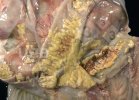Swine dysentery
Swine dysentery is caused by a spirochete called Brachyspira and causes severe inflammation in the large intestine producing bloody and mucous diarrhea.
Alternative names: Brachyspira hyodysenteriae
Information
Swine dysentery is caused by a group of strongly beta hemolytic spirochete called Brachyspira (previously called Serpuline or Treponema) hyodysenteriae (classical agent) and B. hampsonii. These organisms causes severe inflammation in the large intestine producing bloody and mucous diarrhea.
The disease is frequent between 12 and 75 kg, but severe cases occur occasionally in sows and their piglets.
Brachyspira can survive outside the pig up to 112 days, but it dies in 2 days in dry and hot environments. Can be transmitted by birds, flies, fomites and mice.
Spread inside the farm is slow. The number of pigs affected increases as the microorganism accumulates in the environment. Recovered pigs rarely suffer from the disease again, however antibodies (IgG and IgA) do not last long. Therefore, there is not a strong relationship between antibody level and protection. Some sows might not show any symptoms for several months and transmit the disease to their piglets.
The high cost of the disease is associated with mortality (low), morbidity (high), decrease in growth, increase in feed conversion ratio, and the cost of medicated feed.
The incubation period in field cases is normally 7 to 14 days, but it can be up to 60 days. Pigs can initially develop a subclinical carrier state, and afterwards show symptoms if they are under stressing situations or when the diet is changed.
Symptoms
Sows
Clinical symptoms in sows are not frequent, unless the disease appears for the first time on the farm.
Lactating piglets
- May suffer severe acute dysentery.
- Loose light brown feces with or without blood and mucus.
- Loss of body condition.
- Sows are asymptomatic carriers.
Weaners and growers
First symptoms are:
- Watery diarrhea that stains perineal skin.
- Initially the diarrhea has a light brown color with a gel-like consistency, mucus and flakes of blood.
- Sunken flanks.
- Partial loss of appetite.
- In some cases sudden death.
As the disease progresses:
- Blood may appear in gradually higher amounts which makes feces have a dark and tar like color.
- Pigs rapidly lose appetite and body condition.
- Dehydration.
- Thin animals with sunken eyes.
Causes / Contributing Factors
- Pigs get infected from ingesting of contaminated feces.
- The disease is transmitted from carrier pigs (including farrowing sows) who excrete the organism in the feces for a long time.
- Mechanical transmission through infected feces in equipment, feed distribution contaminated trucks, boots and birds.
- May be transmitted through flies, mice, birds and dogs.
- The stress produced when the diet is changed may trigger the disease.
- Poor hygiene and high humidity.
- Crowded conditions.
Diagnosis
- Clinical signs of diarrhea with blood and mucus.
- Necropsy – disease restricted to large intestine.
- Special bacterial culture and identification of a strongly beta hemolytic spirochete.
- PCR of feces.
Control/Prevention
- The following products may be used as treatment: salinomycin, tiamulin, lincomycin, tylosin, monensin.
- Some B. hyodysenteriae strains have developed resistance to these antibiotics.
- When the first signs of the disease are present, water must be medicated with lincomycin, tiamulin or tylosin for at least 7 days.
- The most affected pigs must be injected with lincomycin, tiamulin or tylosin.
- Medicating the diet only helps prevent the development of clinical disease.
- Hygiene and mice control is of paramount importance to control the transmission, especially when it is planned to eradicate the organism.
- There are two general options to eradicate the disease: depopulate and repopulate with disease free sows, or eradicate the disease without depopulating. Both methods are expensive, and the success rate is not 100%, especially with the second option.
- All the replacement animals must originate from a swine dysentery negative farm.
Treatment
- Rodent and wildlife control.
- All-in-all-out pig flow.
- Complete cleaning and disinfection of rooms.
- No comingling of pigs.
- Antibiotics can be used to control disease but require long term use and can be quite expensive.
- Depopulate and repopulate infected farms.
- All the replacement animals must originate from a swine dysentery negative farm.
- Vaccines are available in some areas and may be beneficial (serotype specific).


















